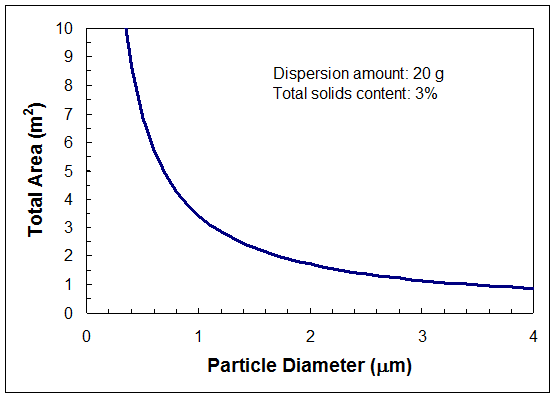During protein (or other kind of molecules) coating onto magnetic particles, there are two main parameters that govern the success of the process: the physical and chemical properties of the protein itself and the magnetic particle dispersions. For this reason, the correct selection of these components is the key for an excellent coating. In this article the importance of physical properties of magnetic dispersions is discussed.
We can say that among others, mean particle size is the parameter that mostly affects the behavior of the dispersion. As a key rule, for the same solid content, the higher the particle size of the particles, the lower the total area available by the particles. For this reason, the amount of protein that can be incorporated to the surface of the particles decreases as the particle size of the dispersion increases. Clearly this effect will determine how the conjugate will work. As an example, the figure below shows the effect of particle size on the total area of 20 g of dispersion at 3% solids content.
Furthermore, mean particle size will determine how fast conjugates will be attracted by the presence of a magnetic field: the higher the particle size, the faster they will be attracted. More than often, there is a compromise between the amount of protein that is wanted to be coupled to the surface of the particle and the separation speed that is desired to obtain under the presence of a magnet.
If you are interested in magnetic bead coatings, download SEPMAG's newest free guide, Magnetic bead coatings: Today and Tomorrow. You can download it through the following link:
Regarding the particle size, there must emphasize that not only mean particle size has an influence on the behavior of the coating; in addition, the particle size distribution (PSD) is an important parameter. Dispersions with narrow PSDs will offer much better reproducibility since chances to obtain a homogeneous coating (amount of particles incorporating the same amount of protein) increases. Besides, having all particles nearly the same particle size, magnetic force under each particle will be nearly the same, and thus the separation will be homogeneous and reproducible.
The picture below shows a sample of 1 µm magnetic particles synthesized at IKERLAT Polymers, obtained with a Scanning Electron Microscope (SEM). There can be seen that particles maintain their identity after the incorporation of the magnetic compound. Regarding the PSD, the picture seems to show a monodisperse sample. Even the presence of aggregates like doublets and triplets are not detectable by this technique, measurements done with a Disc Centrifugue Photosedimentometer (DCP) confirmed the presence of a unique population of single particles in the sample.
-resized-600.png?width=420&height=306&name=image_chapter_6_fig_2_(size_dispersion_sem_picture)-resized-600.png)
Other parameter that must be taken into account is the amount of magnetic compound that incorporates the dispersion, what we will call the magnetic charge. We can say that this value can vary from 10 to 60%. The most evident consequence of increasing this percentage is that a faster separation is obtained under the influence of a magnetic field, which can be very desirable in time depending processes. However, it should be kept in mind that an increase in the magnetic charge implies an increase of the particle density, which can reach values up to 1.9 g/cm3. Sometimes this is a handicap since combining large particles with high particle densities gives high sedimentation speeds, which is not recommended for prolonged processes and it complicates the complete dispersion of the beads.
These are the reasons for which it is recommended to consider the magnetic charge as a variable that can be tuned on demand. As an example, the figure below shows the variation of the separation speed (measured with Sepmag’s QCR) for three magnetic dispersions having different magnetic charges and the same mean diameter.
-resized-600.png?width=416&height=312&name=image_chapter_6_fig_3_(biomagnetic_separation_curves)-resized-600.png)
The arguments exposed in this article evidence the impossibility of having a unique reference of magnetic dispersion that will work on every process. In contrast, the physical (and chemical) properties of the dispersion must be adjusted in order to fulfill your process requirements. For this reason, when selecting a magnetic particle supplier, it is important to check the flexibility they can offer, as this can be the key for your process success. At IKERLAT Polymers, the product personalization becomes our leitmotiv, and we will be very glad to assist you in any subject concerning magnetic particles.
Related articles:
- Surface Attenuation for High Sensitivity Assays
- The 4 today’s surfaces for magnetic beads coating
- Using Tosyl activated magnetic beads in chemiluminescent immunoassays
Author: Dr. Sergio Rubio, IKERLAT Polymers researcher.
 Dr. Sergio Rubio obtained his PhD in Chemisty at the Chemical Engineering Group of the University of the Basque Country (UPV-EHU). Since 2008, Sergio forms part of the R&D department of IKERLAT Polymers, offering solutions to companies and research centers interested in polymer particles, especially for biomedical applications. Before, Sergio has worked as researcher in the UPV-EHU in different projects centered in polymerization in dispersed media.
Dr. Sergio Rubio obtained his PhD in Chemisty at the Chemical Engineering Group of the University of the Basque Country (UPV-EHU). Since 2008, Sergio forms part of the R&D department of IKERLAT Polymers, offering solutions to companies and research centers interested in polymer particles, especially for biomedical applications. Before, Sergio has worked as researcher in the UPV-EHU in different projects centered in polymerization in dispersed media.





